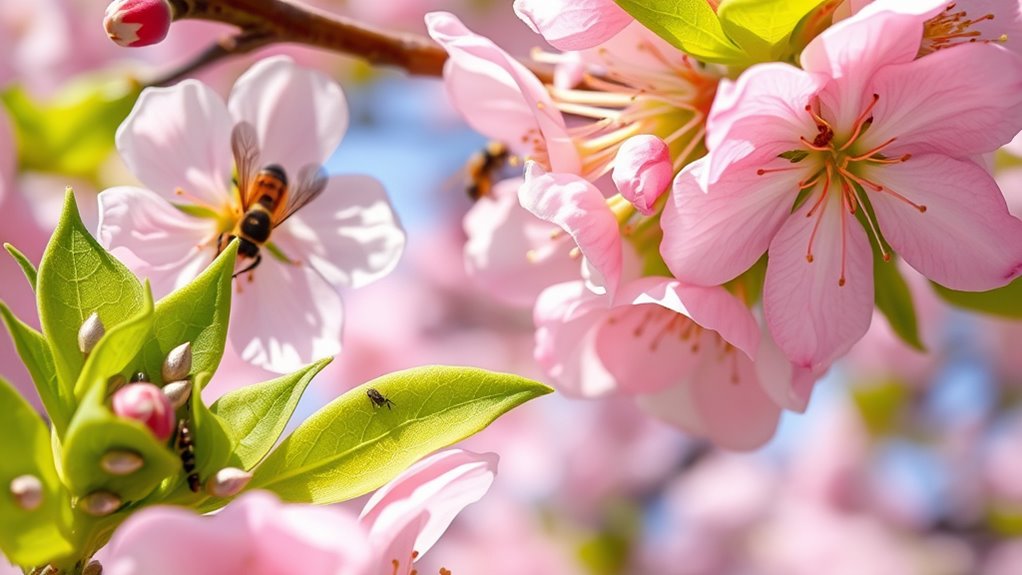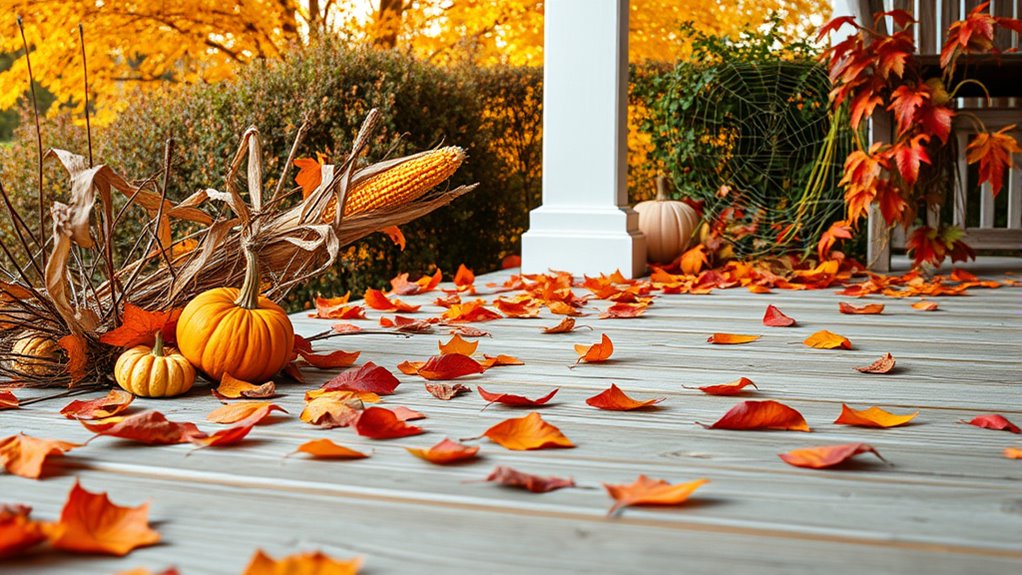As seasons change, you face different pest challenges: in winter to spring, pests seek warm hiding spots and outdoor insects become active, while summer brings swarms of wasps and ticks. Fall pushes rodents and pantry pests indoors as outdoor activity drops. Staying vigilant by sealing entry points, reducing standing water, and maintaining cleanliness helps prevent infestations. To stay ahead of each season’s unique pest risks, keep exploring these key strategies and tips.
Key Takeaways
- Spring sees increased outdoor pests like ants and mosquitoes, along with indoor invaders seeking shelter from cold.
- Summer activity peaks for wasps, hornets, and ticks, with higher indoor insect entry due to outdoor abundance.
- Fall prompts rodents and pantry pests to seek warmth indoors, while outdoor pests prepare for winter.
- Winter transitions cause pests to invade homes via cracks, seeking shelter from cold outdoor conditions.
- Year-round vigilance—sealing gaps, eliminating standing water, and maintaining cleanliness—is essential for effective pest control.

Have you noticed pests becoming more active as the seasons change? It’s a common experience, and understanding why can help you stay ahead of potential infestations. As temperatures shift, both indoor pests and outdoor pests adjust their behaviors, seeking warmth, shelter, or food sources. During colder months, for instance, indoor pests like cockroaches, spiders, and silverfish tend to invade homes more aggressively, exploiting cracks, gaps, and other entry points. They seek refuge from the cold outside and can easily hide in dark corners, behind appliances, or within wall voids. Meanwhile, outdoor pests such as ants, ticks, and mosquitoes become more visible as they seek out hosts or breeding grounds. Warm weather stimulates their activity, causing them to emerge in larger numbers, which can lead to increased outdoor nuisance and even health risks.
In the changeover from winter to spring, you might notice an uptick in outdoor pests like ants and termites, drawn to the warmth and moisture that spring provides. These pests often start nesting outdoors but can quickly find their way inside if given the opportunity. Spring is also prime time for mosquitoes, which breed in standing water and become more active as the weather warms. If you have outdoor plants or gutters, standing water can become a breeding hotspot, making it necessary to regularly eliminate stagnant water to reduce mosquito populations. Simultaneously, indoor pests like flies and pantry pests can become more prevalent as they exploit new food sources or enter homes seeking shelter. Keeping your home clean and sealed becomes vital during this season to prevent infestations.
Summer brings a surge in outdoor pests like wasps, hornets, and ticks, which are more active and aggressive in the heat. Ticks, in particular, pose a health threat as they latch onto pets and humans alike. Outdoors, you’ll want to take precautions like wearing protective clothing and avoiding tall grass. Indoors, the warm weather can also cause an increase in spider activity, as they hunt for insects attracted to your home’s warmth and light. The combination of outdoor activity and indoor vulnerability means you should be vigilant about sealing cracks and maintaining screens on windows and doors. Fall is another challenging season, as outdoor pests like rodents and certain beetles seek warmer shelters, often invading attics and basements. Indoors, pantry pests may become a concern as stored food becomes more attractive with the approaching winter months. Additionally, understanding the importance of attention in maintaining effective pest control can help you identify and address issues early on.
Recognizing these seasonal patterns allows you to take proactive steps—such as sealing entry points, reducing standing water, and maintaining cleanliness—to minimize pest problems. Staying attentive to the behaviors of both indoor and outdoor pests ensures you’re prepared to handle each season’s unique challenges, keeping your home healthier and pest-free year-round.
Frequently Asked Questions
How Can I Identify New Pests Emerging Each Season?
To identify new pests emerging each season, focus on pest identification by observing changes in your environment. Look for seasonal indicators like unusual insect activity, damage to plants, or new pests in your area. Keep track of these signs, and consult local pest control resources or guides. Staying vigilant helps you catch pests early, enabling effective management before they cause serious problems. Regular monitoring is key to staying ahead of seasonal pest changes.
Are There Eco-Friendly Methods to Control Seasonal Pests?
You might think eco-friendly pest control isn’t effective, but biodegradable pesticides and natural repellents prove otherwise. These methods are safe for your family and the environment, effectively managing seasonal pests without harmful chemicals. By using plant-based oils or introducing beneficial insects, you can control pests naturally. Embracing eco-friendly solutions helps protect your home and the planet, making pest control both responsible and successful.
What Preventive Measures Work Across Multiple Seasons?
You want to know what preventive measures work across multiple seasons. Using integrated pest management (IPM) is your best approach, combining biological control methods like natural predators with cultural practices such as proper sanitation and habitat modification. These strategies help reduce pest populations year-round without chemicals. Regular inspections and early intervention are key, ensuring you catch issues before they escalate, making your pest control efforts effective through every season.
How Do Weather Patterns Influence Pest Activity?
Weather patterns greatly influence pest activity as they dictate temperature, humidity, and rainfall. Climate change causes unpredictable shifts, leading to extended pest migration periods and increased outbreaks. Warmer temperatures can make pests active year-round, while heavy rains create breeding grounds. You should stay vigilant, monitor changing weather, and adjust your pest control strategies accordingly, since these patterns directly impact when and where pests become a problem.
When Should I Start Pest Prevention for Upcoming Seasons?
Think of pest prevention timing as setting the stage for a smooth play. You should start your efforts before seasonal pest trends peak—typically a few weeks ahead of changing weather patterns. For example, begin early spring for ants and termites, and late summer for mosquitoes. By staying proactive, you keep pests at bay and protect your home, ensuring you’re always one step ahead in the game of pest control.
Conclusion
As you stay vigilant through each season, remember that pests can be both a nuisance and a sign of change. While summer brings swarms and warmth, winter’s silence conceals lurking pests waiting to reemerge. By staying alert year-round, you protect your home and peace of mind. Just as seasons shift and adapt, so must your pest control efforts—embracing change now ensures you’re prepared for whatever’s next. Stay proactive; stay protected.









